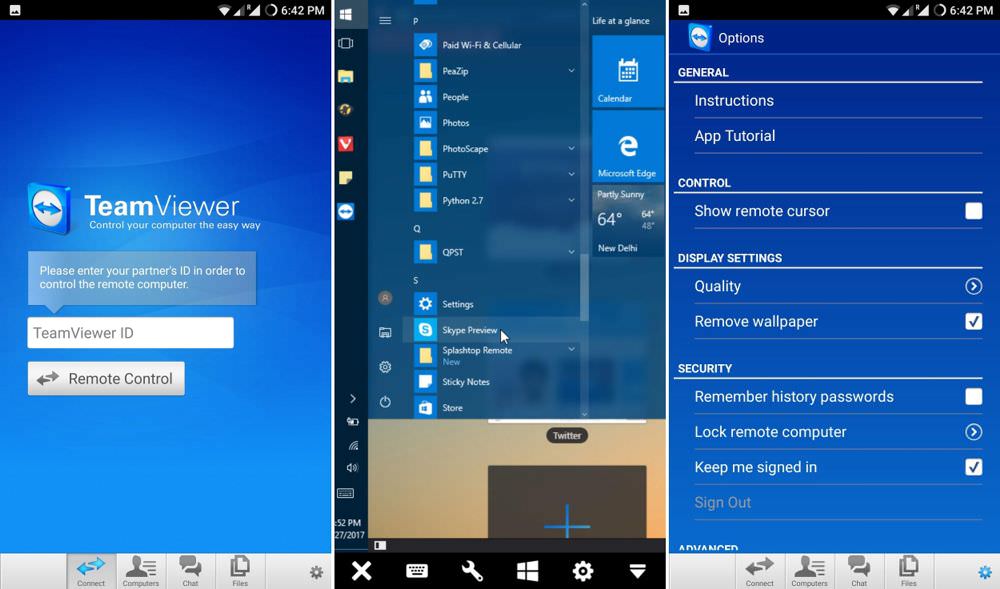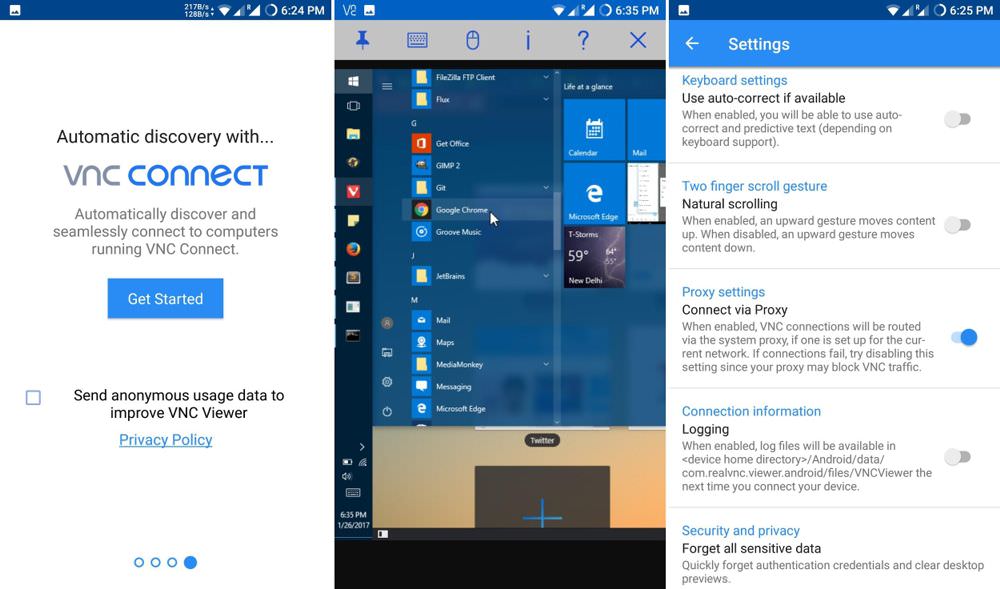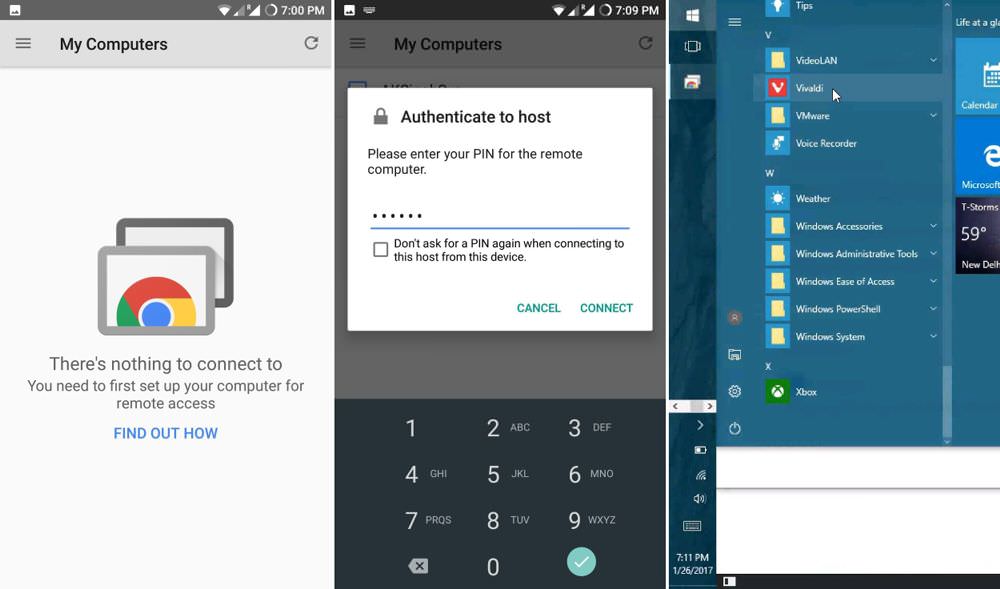5 Best Free Android Apps to Remote Control Your PC
Android is a wonderful operating system that you can use in many different ways. You can connect your PC to Android device, connect PC hardware to Android device and even access your PC remotely or remote access your Mac from another device.
Well, this post covers some remote control apps that help you remotely access and securely control your desktop, a mobile or a server. Such apps come handy on various situations where you can’t access your system in personal.
The process is extremely simple: just setup RDP or VNC on your system, and install and configure compatible apps on your computer and the Android device. Then you can securely connect to the configured system from anywhere in the world, say from the comfort of your sofa or from the deserts of India.
In this post, we’ll take a look at the five of the best Android apps, which help to remotely access and control your computer from almost anywhere with an Internet connection.
1. TeamViewer

If you’re looking for an all-in-one remote control solution, then TeamViewer is the product you’re looking for. It provides amazingly fast and secure access to computers and mobile devices.
The tool helps you or your team to access any system remotely, provide online support to customers and administer unattended computers or servers across different platforms.
TeamViewer is no doubt the easiest and most feature-ful tool for remote control as compared to the other solutions in this list. It also offers support for more number of devices than any other solution, making it the best choice if you’re looking for a multi-platform solution.
Pros:
TeamViewer comes with numerous attractive features such as:
- Connect to all major desktop and mobile platforms including Windows, macOS, Linux, Chrome OS, Android, iOS, Windows Phone and BlackBerry OS.
- Supports screen sharing as well as complete control of remote devices.
- Single window console to manage contacts, devices, sessions and more.
- Offers chat and VoIP features for making calls, conferences and meetings.
- Record the remote sessions including screen, audio & video and VoIP.
- Shared clipboard allows copying and pasting text, images and files easily.
- Transfer files with speed up to 200 MB/s across any two remote devices.
- Supports controlled access via trusted devices as well as white and blacklists.
- Secures the remote connection with powerful 256-bit AES to encrypt sessions and 2048-bit RSA for key exchange along with optional two-factor authentication.
- Free for personal use but doesn’t include various advanced features.
- Offers online help videos and support documents including how-to tutorials.
Cons:
TeamViewer does lack at some places, for example:
- Doesn’t connect to systems running open-source VNC or third-party VNC software like TightVNC, UltraVNC, etc.
- It’s a proprietary software that comes for premium price for business users.
2. VNC Viewer

VNC Viewer is a remote control app from RealVNC (innovators of VNC itself) that gives you instant remote access of your computers or servers from anywhere using your mobile.
VNC Viewer establishes secure, seamless and reliable cloud connections to VNC or VNC Connect compatible computers without the need of any network configuration.
If you’re searching for a free and open source solution, then VNC Viewer is your only option in this list. Though the app is itself not open sourced, but contrary to other tools, it can connect to computers running open-source VNC.
However, you may find some features missing while using open-source option.
Pros:
VNC Viewer offers various awesome features as listed below:
- Connects to all popular desktop operating systems such as Windows, Mac, Linux and also to Raspberry Pi.
- Connects to computers using open-source VNC or third-party VNC-compatible software like TightVNC, Apple Screen Sharing, etc.
- Provides backup and sync connection details using the RealVNC’s cloud account.
- Supports Bluetooth keyboards and mices for easy control on mobile devices.
- Offers multiple authentication schemes to prevent unauthorized access.
- Encrypt whole connections to prevent eavesdropping by malicious entities.
- Blacklists the users failing authentication to prevent attacks and port scan.
- Avails online documentation as well as support through chat and email.
- Offers cloud-only, free subscription of VNC Connect for home users.
Cons:
VNC Viewer lacks at various points in comparison to others like:
- Can’t connect to mobile platforms.
- Costs premium price for its VNC Connect to business users .
- Doesn’t support file transfer feature to/from free home subscription and using Android, iOS and Chrome-powered devices.
3. Microsoft Remote Desktop

Microsoft Remote Desktop is the best go-to tool to get work done on a Windows system remotely using an Android mobile device.
It doesn’t need any software installation on the remote system until that runs Windows and you know how to configure Remote Desktop. If not, then you only need to install Remote Desktop Assistant and it does all for you.
Microsoft Remote Desktop is the right choice for you if you’re looking for a Windows-only solution. Though the tool doesn’t work for any other platform yet it works like a charm to remote control a Windows PC.
It’s packed with basic features like shared clipboard but lacks advanced features offered by others such as file transfer, chat and voice call, etc.
Pros:
Below are the some of the best features of the Remote Desktop client by Microsoft:
- Connect to Windows OS for desktops and servers only.
- Rich multi-touch experience supporting Windows gestures using RemoteFX.
- Access to remote resources like printers using Remote Desktop Gateway (the same need to be configured on your network).
- Access to local storage of Android from the remote Windows applications.
- Secure connection to the remote computer using Network Layer Authentication.
- High quality audio and video support using advanced bandwidth compression.
- Comes for free for everyone though some features are only for enterprise users.
Cons:
Microsoft Remote Desktop lags behind at some frontiers such as:
- Can’t connect to other opertating systems than Windows.
- Proprietary technology that can’t connect to Windows 10 Home.
4. Chrome Remote Desktop

Chrome Remote Desktop is a unique browser extension for Google Chrome to access a PC Mac or Linux desktop easily and securely from any Android device.
This makes possible any Chrome user to give remote assistance or access a remote computer over the Internet using just Google Chrome browser on numerous operating systems.
If you love everything Google and require a sweet and simple remote control solution, then Chrome Remote Desktop is just for you. It’s the only multi-platform tool that’s freely-available for commercial use unlike all other solutions in this list, hence if you’re planning to set up remote control in your organization, then Chrome Remote Desktop can serve the purpose.
Related: How to Setup and Run Google Remote Desktop.
Pros:
Some of the most interesting attributes of Chrome Remote Desktop are:
- Connect to Windows, macOS and Linux desktops.
- One-time authentication code to share with or get access.
- Able to set up screen sharing as well as remote assistance.
- Manage saved session or connection details at a single place.
- Streams audio and supports functional copy-paste for Windows.
- Encrypted sessions using Chrome’s SSL features including AES.
- Free to install and use for personal as well as commercial work.
Cons:
Few of the pain points of Chrome Remote Desktop are:
- Can’t access local storage or resources in remote apps.
- Doesn’t support file transfer for every platform.
5. Splashtop 2

Last but not the least, we have Splashtop. It’s a secure remote control app that gives full access to applications, multimedia files, games and more on the remote computer.
It’s easy to setup a remote control connection using its Splashtop Streamer on the remote computer.
If you’re looking for a local network solution, then Splashtop is the best tool for you. Though its online remote control works only for premium subscription yet its features make it worthy to try on local connections.
You can access and stream music and media stored on your computer from mobile devices.
Pros:
The distinct factors of Splashtop are:
- Connects to Windows and MacOS platforms only.
- Connects from various devices including Kindle Fire and Windows Phone.
- High definition audio and video streaming on the remote connections.
- Strong encryption including logging, audit trails and multi-level passwords.
- Business features include file transfer, remote print, chat and multi-user access.
- Free for use on the local network to access your computer from another room.
Cons:
SplashTop does come with some weak points too, such as:
- No free option to access your home computer from anywhere using Internet.
- Can’t connect to Linux systems.
Summary
TeamViewer is highly recommended for personal use as it’s easy to use and allows screen sharing, remote control and more. Chrome Remote Desktop works without any software installation and thus, beneficial for setting up remote assistance or control on machines without admin or root privileges
Lastly, Windows Remote Desktop is for anyone using Windows with basic remote control requirements.
For better understanding of the readers, bellow is a table of all the aforementioend apps along with the features they do or do not have.
| Connect to | Chat and VoIP | Transfer files | Encrypts session | Free for | |
| TeamViewer | Windows, macOS, Linux, Chrome OS | Yes | Yes | Yes | Personal use |
| VNC Viewer | Windows, macOS, Linux, Raspberry Pi | No | No | Yes | Personal use |
| Microsoft Remote Desktop | Windows | No | Yes | Yes | Personal & commercial use |
| Chrome Remote Desktop | Windows, macOS, Linux | No | No | Yes | Personal & commercial use |
| Splashtop 2 | Windows, macOS | No | No | Yes | Personal use |
Do you use any of these remote control apps? What’s your any-time experience of using a remote control application? We’d like to hear from you.